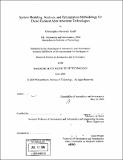System modeling, analysis, and optimization methodology for diesel exhaust after-treatment technologies
Author(s)
Graff, Christopher Dominic
DownloadFull printable version (27.83Mb)
Alternative title
Diesel exhaust after-treatment technologies
Other Contributors
Massachusetts Institute of Technology. Dept. of Aeronautics and Astronautics.
Advisor
Olivier L. de Weck.
Terms of use
Metadata
Show full item recordAbstract
Developing new aftertreatment technologies to meet emission regulations for diesel engines is a growing problem for many automotive companies and suppliers. Balancing manufacturing cost, meeting emission performance, developing competitive engine power, reducing weight and operational costs are all tradeoffs that companies and operators have to resolve for new aftertreatment technologies. However, no single technology has been able to address the wide range of performance and cost objectives in this field. The traditional design philosophy of developing components, optimizing them for particular operation states, and then adding them together into a system may not yield the best solution to this complex problem. Manufacturers may not be able to offer the best balance of performance and cost developing systems in this manner. Two useful product development tools that can address this issue is Systems Architecture and multidisciplinary design optimization (MDO). This thesis develops and exercises a framework for modeling, designing, analyzing, and optimizing of complex diesel exhaust after-treatment systems. (cont.) The methodology presented addresses the issue of complexity of systems and their components, and how to use systems architecture to develop a modeling technique that allows for flexibility in design, coding and analysis. The framework also addresses the analysis of exhaust system models, and utilizes multidisciplinary system design optimization to improve the design of exhaust systems. It also shows how using a system design and optimization methodology can yield better system designs than the more traditional design and development method that addresses only one technological component at a time. Two case studies are presented to validate the framework and methodology, and a set of design solutions for each case are found. A modeling and simulation tool was also developed for this thesis, and presented. The valuable information gleaned from this analysis can assist engineers and designers in identifying design directions and developing complete diesel emissions treatment solutions.
Description
Thesis (S.M.)--Massachusetts Institute of Technology, Dept. of Aeronautics and Astronautics, 2006. Includes bibliographical references (p. 152-155).
Date issued
2006Department
Massachusetts Institute of Technology. Department of Aeronautics and AstronauticsPublisher
Massachusetts Institute of Technology
Keywords
Aeronautics and Astronautics.